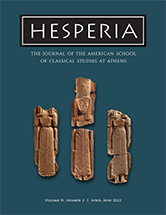Hesperia 91.2 Now Online!

We are pleased to announce the publication of Hesperia 91.2! Topics in this issue include an examination of the evidence for the construction of the grave of the Griffin Warrior at Pylos, a 7th-century B.C. deposit of votive material at Anavlochos on Crete, stone tools from the Classical city-state of Halieis, and new digital visualizations for Antenor’s Tyrannicides statues in the Athenian Agora.
Subscribers can read the issue online at Project MUSE, which now hosts current issues of Hesperia as well as an archive of past volumes dating to 2002. Hesperia remains on JSTOR as part of their Arts and Sciences II package, with the usual three-year moving wall. Additionally, all issues of Hesperia from 2011 and earlier are available as Open Access on our website. The printed version will be mailed shortly.
The Grave of the Griffin Warrior at Pylos: Construction, Burial, and Aftermath, by Sharon R. Stocker, Calla McNamee, Salvatore Vitale, Panayiotis Karkanas, and Jack L. Davis, discusses the circumstances of the discovery, stratigraphy, and construction of the grave of the Griffin Warrior. which were described briefly in 2016 as an introduction to a detailed presentation of the four gold rings found inside it. Here, the “life history” of the grave is considered fully. As a sealed context, the grave of the Griffin Warrior also provides a key dated context for many classes of artifact, the chronologies of which have not hitherto been well defined. Because of its importance in this regard, supporting evidence is presented that the Griffin Warrior was buried in Late Helladic IIA and that the burial deposit in the grave lay undisturbed after Late Helladic IIA.
Votive Keimelia from Crete: Homeric Perspectives on a 7th-Century Deposit of Curated Objects, by Florence Gaignerot-Driessen, details the fact that recent excavations at Anavlochos in eastern Crete revealed votive material, consisting mostly of female figurines, deposited in natural rock cavities of a mountain ridge. One cavity stands out from the rest of the deposit for its anomalous finds, which notably include a Minoan sealstone. The various offerings from this “sealstone cavity,” all curated objects, were probably deposited in the 7th century B.C. An examination of the use and meaning of curated objects (keimelia) in the Homeric epics shows that they could represent substitutes for a missing person.
Flaked Stone Tools and Domestic Economy in a Classical Polis: Lithics from the Lower Town at Halieis, Greece, by P. Nick Kardulias and Curtis N. Runnels, examine how an assemblage from the Classical city-state of Halieis in the southern Argolid demonstrates the continued use of lithics in historic periods. Such examples of worked stone from historic contexts have received less attention than objects made of other materials because of the reduced role for stone tools following the advent of metallurgy in the Bronze Age. The Halieis material, consisting largely of obsidian blades, with few cores and other production residue, reflects either primary reduction off-site and importation of finished tools or preforms, or recycling of older material. Despite the assemblage’s small size, the lithics reveal nuances of an underreported aspect of the ancient Greek economy.
Fear and Loathing in the Hellenistic Agora: Antenor’s Tyrannicides Return, by Andrew Stewart, Bernard Frischer, and Mohamed Abdelaziz, uses new interactive digital reconstructions to propose that a particular statue base in the Athenian Agora could have accommodated both pairs of Tyrannicides after Alexander returned Antenor’s from Persia in 323 B.C.; that it would have revived a famous Athenian commemorative tactic after the Persian withdrawal in 479; that the monument’s potency as an icon of Athenian fear and loathing of tyranny evolved but did not necessarily shrink under the Successors; and that any other candidate for its Hellenistic and later appearance should echo, more or less, this base’s dimensions, form, and construction.
Click here to subscribe to Hesperia. In addition to receiving printed issues and online access to Hesperia, subscribers also receive complimentary online access to Hesperia Supplements, and Agora and Corinth volumes.
Hesperia welcomes submissions from scholars working on all aspects of Greek material culture, including archaeology, art, architecture, history, epigraphy, and related studies. Further information about the journal, including instructions for preparing manuscripts for submission, can be found on our website.
The Friends of Hesperia was founded in 2014 to help fund the journal's growth in all its manifestations. We invite you to become a member today and help support one of the most preeminent journals in the field of Mediterranean archaeology.